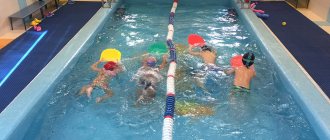Dynamic gymnastics for infants is a technique offered to new parents for the physical development of a child. In specialized schools for young parents, its principles are often taught to mothers and fathers at the stage of preparation for childbirth. But instructors do not always explain in detail what this program is and how it affects the growth and development of a newborn child.
“When to start dynamic gymnastics, what will it give my baby, does the technique entail any danger?” – Parents have a lot of questions to which they cannot find an answer for a long time. We do not in any way encourage you to use this method and do not insist on anything. But today we would like to highlight dynamic gymnastics for “beginning” parents from different angles, according to several points of view of the country’s leading pediatricians.
The principle of dynamic gymnastics: what is the point?
From the moment the child is born, pediatricians recommend giving him a light massage and gymnastics daily. These are mandatory procedures to strengthen the muscles of the whole body. Only normal physical development is the key to the fact that the baby will learn to hold his head, then sit, crawl, stand on his feet and then walk. But some parents prefer more energetic exercises - dynamic gymnastics.
Dynamic gymnastics includes a set of exercises, during which the child’s muscles are strengthened and developed. It also helps train the vestibular apparatus.
The exercises that adults perform with babies are more like acrobatic studies, so many are perplexed as to how one can perform such exercises with children under the age of one year, when the baby’s spine and bones are so fragile that they can easily be damaged. Dynamic gymnastics experts warn that not all parents can train their children on their own. At first, it is recommended to attend classes with an instructor or invite him to your home.
Improper exercise technique can lead to various injuries to the baby. Therefore, parents should be extremely careful when engaging in dynamic charging with their baby.
This type of gymnastics includes several types of exercises that must be performed in combination:
- hardening: this does not mean that babies are doused with cold water from birth, absolutely not. The principle of hardening is to wear light clothes at home; the baby spends a lot of time without clothes, taking air baths. Older children walk on the floor without socks. Every evening the child should take a cool bath, but the baby is taught to gradually reduce the temperature of the water;
- exercises in the air: it is this stage that causes the most controversy among parents and doctors;
- massage: helps strengthen and relax the muscles of the whole body;
- exercises on a fitball: recently, exercises on this unique simulator have been very popular. Women begin to exercise during pregnancy, and then adapt their child to such activities. Doctors speak positively about exercises on a fitball, because... During classes, the muscles of the neck and back are strengthened, and the vestibular apparatus is also trained.
Positive aspects: what are the benefits for infants and newborn babies
- It has a positive effect not only on the physical development of children, but also on the psycho-emotional state.
- Thanks to vigorous exercise, babies quickly strengthen their muscles, develop joints in their limbs, and develop flexibility throughout their entire body.
- A close connection with parents allows the baby to better perceive the world around him, because the child feels the closeness of his closest people and trusts them in everything.
- Children quickly learn to navigate in space. This is due to the fact that during exercises the baby sees objects from different angles.
- It has a positive effect on muscle tone: it strengthens and increases its activity.
- Strengthens the body's defenses and improves immunity.
- Plays an important role in the development of the infant's nervous system.
- Coordination of movements in children improves.
- Helps correct torticollis, normalizes the functioning of the digestive system.
- All metabolic processes in the baby’s body are activated. Children who engage in dynamic gymnastics can boast of an excellent appetite.
- Based on the experience of parents, children who actively engage in this type of gymnastics sleep well, are less capricious and are completely non-irritable.
Exercises on a fitball are not only useful, but also fun.
Specialists in dynamic gymnastics believe that this set of exercises is especially useful for children born by cesarean section. After all, at the moment of birth, babies do not pass through the birth canal, which is provided by nature. During the exercises, a kind of compensation occurs for insufficient birth experience. In this way, the child’s adaptation mechanisms in the world around him are launched faster.
Dr. Komarovsky speaks positively about dynamic gymnastics classes with infants. However, she pays special attention to compliance with all the rules for safe exercise, and only at the request of the baby. If the baby is afraid, cries and does not want to study at the moment or at all, you should not force him. All classes should be conducted in a playful way so that the baby feels comfortable and secure. The same applies to parents: if adults are not confident in themselves, their knowledge and skills, they should not start. It’s better to go to an instructor or choose completely different exercises for your baby.
If you personally are scared, don’t force yourself. In the end, spins and re-rolls are completely optional. Those. I am for gymnastics, but without extremism.
Komarovsky E. O., pediatrician
How dangerous can this kind of exercise be?
- The first argument against dynamic gymnastics is given by doctors: many of them believe that such exercises are a huge stress for the baby. The child is just beginning to get acquainted with the world around him, new people and objects. Even the ability to obtain food and perceive it requires some effort, because all the organs and systems of the baby adapt to the new living environment. And during such vigorous activities, a huge release of stress hormones occurs. Experts suggest that this situation can cause hyperactivity in older age.
- Not all parents are experts in performing a set of exercises. Therefore, mistakes during exercise can cause vertebral injuries, sprains in the baby, microtrauma of the joints, as well as circulatory disorders.
- Some psychologists put forward a theory that many parents agree with. Its meaning is that from birth children get used to the feeling of flight and speed, but they do not fall, because... they are always held by the hands of an adult. In this regard, children do not have a fear of heights, so for older children this can cause various types of injuries.
Video: Dynamic gymnastics for a baby in the first year of life
https://youtu.be/4HMVuM8qxbg
What to consider?
When deciding to start practicing the Trunov and Kitaev system, parents should carefully weigh the pros and cons. Many pediatricians and child psychologists argue that possible dangers cannot be ignored. Even if parents are in favor of dynamic gymnastics, they should know everything against it in order to minimize the risks.
First of all, such gymnastics is undeniably stressful for a newborn. Not just stress, but intense stress. Nowhere in nature is it customary to shake, toss and spin babies in the air. Look how carefully the cat carries the kittens, and how carefully other animals do this. Human cubs, from the point of view of natural laws, also have no prerequisites from birth to begin to fly and turn over in the air. Therefore, stress is inevitable.
It can be minimized only with the right approach - knowing when to start such exercises and how to increase the load. It is better to introduce dynamic exercises gradually so that the baby has a smoother transition to an atypical body position.
Many exercises in the Kitaev and Trunov system are based on the use of the baby’s innate reflexes. But such reflexes should disappear by the age of 3-4 months, this is quite natural. If you overdo it with dynamic gymnastics, a slow decline in infant reflexes will occur, which will slow down the child’s development.
Traumatologists warn that it can be difficult for parents to balance their strength, and therefore, after the first experiments in dynamic gymnastics without the participation of a specialist, children often end up in the hospital with sprains, fractures and other injuries. And psychologists warn that a child may develop an incorrect perception of heights, which in the future may make him a brilliant skydiver or climber, but can also cause fatal injuries due to the lack of a natural sense of fear necessary for survival.
Author's method of dynamic gymnastics
In the early 90s, the book “Ecology of Infancy” appeared on sale. First year". The authors of this publication are swimming and conditioning instructors, as well as baby yoga instructors Mikhail Trunov and Leonid Kitaev. The book made a mixed impression among young parents and doctors, because... its pages described very extreme exercises with newborn children.
The authors of the dynamic gymnastics method emphasize that they did not discover anything new, but simply rely on historical data. In ancient times, women could not afford to simply sit at home with a newborn child. The stress and pace of life forced them to engage in physical labor almost immediately after giving birth. Therefore, they sought to adapt the baby as early as possible and adapt him to the new world, where great attention was paid to physical development.
Dynamic gymnastics is aimed at the rapid development of the baby’s physical characteristics.
The essence of the technique is to develop the physical potential of the child in the first year of life. And only after this can parents begin to develop the child’s intellectual abilities. In their book, the authors described more than 400 different exercises, during which parents, at a very active pace, toss the baby, rock and rotate him. At the same time, holding the baby by one or two arms, legs, and also rotating the baby around your body.
According to this method, it is necessary to start working with babies from the first months of life and continue as long as the parents can hold the baby and perform exercises with him. But it’s worth paying attention: if you didn’t start working with your child before six months, you can’t do this later. The fact is that the baby’s muscles are not prepared for these types of exercises and exercise can cause sprains and injuries.
According to the authors, one of the main rules of dynamic gymnastics is a properly organized space for practicing:
- the room should be well ventilated immediately before starting the exercises;
- cool indoor air;
- the baby must be completely naked.
Many parents do not use the full set of exercises, but select only parts. Fitball exercises are the most popular because... they do not require much preparation or special knowledge from parents.
Video: Dynamic gymnastics class with a three-month-old baby
Reviews
Many parents discussing on the Internet the possibility of doing dynamic gymnastics with their infants emphasize that authoritative osteopaths, psychologists and surgeons categorically object to such exercises not only because of the traumatic danger, but also because of the initially dubious benefits for the development of the child. The vestibular system should develop gradually, and not under stress.
Some parents refuse to practice dynamic gymnastics after the first lesson from a professional - most mothers find it completely unbearable to even watch their child being twisted around like a rag doll.
Some parents quite successfully use exercises, but not entirely dynamic ones, but only the simplest and safest of the complex; they usually complete the most ordinary home massage and habitual daily gymnastics.
A specialist in therapeutic and restorative massage will talk about the intricacies of performing dynamic gymnastics for infants at home in the following video.
medical reviewer, psychosomatics specialist, mother of 4 children
Source
When and where to start
Experts have different opinions about the optimal age at which you can start doing dynamic gymnastics with a baby:
- some of them claim that the first classes can be carried out within two weeks after the baby is born. They argue their position by the fact that in this case the baby is protected from tendon sprains and joint injuries;
- Many pediatricians recommend starting to do exercises from the age of one month, when the baby gets a little stronger. The sooner you start classes, the better the child adapts to his new environment thanks to close contact with his parents;
- however, there are also doctors who insist that it is better to practice dynamic gymnastics no earlier than the child turns three months old. But the authors of the methodology claim that this is quite a late date.
Most experts are of the opinion that it is necessary to begin accustoming the baby to exercises with dynamic gymnastics from four weeks after birth.
Video: Starting dynamic gymnastics classes
Basic rules for conducting classes
- Before introducing your baby to these types of exercises, you should consult your doctor. If the pediatrician and neurologist do not mind, you can try to start working with the baby.
- At the beginning, it is recommended to invite an experienced specialist who will show and explain how to properly perform various exercises.
- The first lessons should not last longer than 8–10 minutes, so that the child does not get tired or scared.
- It is worth remembering that active exercises in the air should be done only after a massage, so that the muscles and ligaments are warmed up and prepared for further exercises. Otherwise, the baby's tendons can be stretched.
- It is recommended to perform exercises daily, gradually increasing the procedure time from 10 to 20 minutes. It is not recommended to work with infants for more than this time.
- You should not exercise immediately after eating: at least an hour and a half should pass before you start exercising. It is also not recommended to do dynamic gymnastics before bed: in the evening the baby should be calm and relaxed.
- In the warm season, when the air temperature outside is 20–25°C, it is better to do gymnastics outside.
- During classes, the child should not be wearing any clothes, or something very light: panties and a T-shirt, a bodysuit or one diaper.
- If a child does not want to study, is naughty or cries, you should not force him. It is better to postpone the exercises to another time or day. Accustom your baby to activities gradually so that he begins to perceive it as a kind of obligatory ritual.
The authors and followers of the technique note the obligatory positive emotional state of the baby during the exercises. Parents should calmly talk to the baby during the massage and always stroke it with warm hands so that the child does not get scared. At the first stage, trusting contact is established between the baby and parents. Therefore, while performing such active elements of gymnastics, children are not at all afraid and are ready to trust adults in everything.
You can’t start classes right away with the active part: the baby needs to be prepared through massage and talking
How to avoid injuries and negative emotions: safety precautions
- Despite the fact that all the exercises are quite active, it is recommended to perform them at the same pace and smoothly, so that the child is not afraid of sudden movements and does not stray from the familiar rhythm.
- It is recommended to lay mats on the floor, and conduct classes in a spare room or room where there are no sharp corners or other objects nearby that the baby could hit.
- Instructors always recommend starting classes only with those exercises that the child likes, and then moving on to new ones or those that the baby does not really understand.
- If the baby gets scared during classes, parents need to immediately stop doing the exercise and distract the baby. You can move to the ball, or show him a toy, relax the baby with light stroking movements. Then smoothly perform several exercises that the child perceives easily and with pleasure. But the next day it is recommended to try again to complete the task that the baby did not like.
- Often, while performing certain elements, the baby can clearly hear clicking sounds in the joints of the arms or legs. It shouldn’t be like this, so the lesson needs to be stopped and checked if everything is okay with the child: you can bend the limbs, if the baby doesn’t react by crying, then everything is okay. If the baby is in a good mood and nothing hurts, you can continue the lesson, but make sure that there are no clicks and do not put a lot of stress on those joints that clicked.
Video: How to hold a baby correctly
In what cases are dynamic gymnastics classes contraindicated?
Such exercises can be useful only if contraindications are taken into account. In some cases, a specialist may categorically prohibit parents from engaging in dynamic gymnastics with their baby. Therefore, children who have the following diagnoses cannot practice these types of active activities and exercises:
- hip dysplasia;
- congenital pathologies of the musculoskeletal system;
- increased intracranial pressure;
- lesions and disturbances in the functioning of the nervous system;
- Congenital heart defect;
- The child's age is six months or older to start classes.
General rules
If, despite all the warnings, parents are determined to do dynamic gymnastics with their baby, they must definitely enroll in a special group led by so-called baby trainers and exercise therapy specialists in order to see how professionals do it and learn the techniques. We are talking about the health of your baby; bargaining, as they say, is inappropriate here.
Experts recommend starting to engage in this type of physical exercise with your baby no earlier than 1.5 months.
It is important that the child has no contraindications. We will talk about them below. Therefore, good and correct trainers always ask parents for a certificate from the pediatrician stating that the doctor does not object to training. You also need to prepare for the fact that doctors usually refuse to give such a certificate - no one wants to take responsibility for the life of a child if the parents decide to test certain methods on him.
The Internet and video tutorials, which can be very useful in mastering the techniques of classical massage and gymnastics for infants, are not helpful in matters of dynamic gymnastics. You cannot study remotely.
How to deal with newborns
As we said earlier, dynamic gymnastics consists of several stages. For newborns, you can only perform massage and exercises on a fitball. The most active set of exercises, exercises in the air, are allowed to begin no earlier than the baby turns one month old. And in the first month of life, it is necessary to strengthen the muscles of the body and physically develop the baby with the help of massage and exercises. First of all, you should do a massage and warm-up for the baby to prepare the body for more active exercises in the air:
- position on the back, stroking movements from top to bottom across the baby’s arms and legs, along the stomach;
- then you should perform a light massage of the baby’s fingers. You can use rubber balls;
- massage of feet and toes. Turn your feet in one direction and the other;
- bend the baby’s legs one by one;
- Grasp the child’s knees with your hands and spread your legs to the sides;
- in the position on the stomach, spread the baby’s legs to the sides: “frog” position;
- Perform stroking movements on the baby's back, legs and arms.
Exercises on a fitball should be performed after warming up and active exercises in the air.
Table: Physical exercises for newborn babies
| What part of the body is the exercise aimed at? | Execution principle |
| Hands |
|
| Legs |
|
| Back |
|
| Neck |
|
It should be remembered that one exercise should be repeated as many times as the number of feedings the baby receives per day.
After the massage, you can move on to more active activities - exercises on a fitball:
- The baby should be placed on his stomach. An adult holds the baby behind his back with one hand, and both feet with the other. We begin to rock the baby forward and backward, and then to the sides. The exercise can be repeated five to six times;
Light rocking exercises the baby's vestibular apparatus - we continue rocking, but the baby lies on his back;
While performing the exercise, you need to talk to the baby - This exercise is performed in two positions: first on the back, then on the stomach. Place the baby on the fitball, hold the legs with one hand, and with the other put a little pressure on the buttocks so that the ball springs a little under the child;
Spring exercises can be performed on both the stomach and back - the child lies on his stomach. We put a bright toy on the floor. Holding the baby by the legs, you need to tilt the ball so that the baby tries to touch the toy.
This exercise is great for training your neck muscles.
These two stages must be performed in combination daily so that the child gradually gets used to it and perceives physical exercise as an obligatory, daily ritual. A month after birth, the baby will calmly accept massage and exercises on the ball in order to move on to more dynamic elements.
Video: Fitball exercises with a baby
Contraindications
Dynamic exercises are strictly contraindicated for children with the following problems:
- birth injuries;
- hip dysplasia, physiological immaturity of the joints;
- underweight (low birth weight);
- the presence of an inguinal or umbilical hernia;
- congenital heart defects;
- various neurological disorders, including ischemia.
Please note that the authors of the methodology themselves emphasize that it makes sense to conduct classes only at an early age.
If the baby developed and lived like everyone else until 6 months old, he was given a regular massage and regular exercises, switching to a dynamic program is useless and very dangerous. There will be no benefit from it for such a big child who has not previously done this.
Dynamic gymnastics exercises for children under one year old
Starting from two to three months, you can supplement daily activities with more active elements. But you shouldn’t try new exercises all at once: you should start with one, if the child perceives it well and performs it with pleasure, after a few days you can add another, etc. When performing such actions, it is worth remembering the safety rules so as not to harm the baby:
- The technique for performing all new elements must be demonstrated by a specialist. The fact is that the correct execution of the exercise depends on the grip. But it is difficult for parents to understand on their own how to properly hold their child. In order not to harm the baby, it is better to consult a specialist;
- instructors do not recommend performing exercises when parents are unsure or afraid. The fact is that the effectiveness of the element depends on clear movements. But if mom or dad slows down or loses rhythm, it can lead to a sprained ligament or dislocated limb. It’s better not to risk the baby’s health;
- If a child is afraid of some exercise, do not insist and continue doing it. The correct option is to put this element aside for a while and try it later.
Video: Exercises with a four-month-old baby
Experts recommend selecting a set of exercises for each child individually, depending on the physical development and health of the baby. At the beginning, instructors show the baby the simplest exercises so as not to scare the baby. With a two to three month old baby you can do the following exercises in the air:
- stretching: the baby rests his feet on the stomach of mom or dad. The parents, in turn, pull the baby by the hands closer to them. Then lower the baby to its original position;
- Swinging in the air: Take the baby by both hands and lift him into the air. Then slowly spread your arms to the sides and back;
- lift the child up and down, holding him by the hands;
- While continuing to hold the baby by the hands, transfer the weight to one hand and release the other for two seconds, then do the same with the other hand;
- swing the baby forward, backward and right, left. Rocking a baby in your arms is one of the first dynamic gymnastics exercises that a baby is introduced to.
We must not forget that all exercises in the air are possible only after a massage.
Video: Massage and gymnastics for three-month-old babies
As soon as the child gets used to the first exercises in the air, you can add more complex exercises. Experts recommend introducing your baby to a new exercise every three days. But this is provided that the child perceives the previous one well. There are times when a child is happy to complete tasks, but is afraid to do some elements or is unpleasant for him. You shouldn’t force the baby; it’s better to choose other exercises. Let's look at the most popular exercises that can be performed with children three to four months old:
- cross: to perform this exercise, you need to spread the child’s arms in both directions. Adults take the baby and slowly lift him up, and then smoothly lower him back. This exercise can be performed in a slightly different way: take the child by the hand with one hand and the leg with the other. And spread both limbs in different directions; This exercise is aimed at strengthening the baby's arm muscles.
- monkey: we securely grab the baby by the hands and gradually rock him. Then you need to take the child by the hand and leg and rock him in this way;
As practice shows, kids really love this exercise: it gives them the feeling of flying. - pendulum: hold the baby by both legs with both hands. And start swinging the baby first in one direction, then in the other direction. You can also lift your baby up and down. Then take the baby by the hands and repeat the exercise in this position;
The exercise is performed by holding the baby first by the arms and then by the legs.
- exercise on a fitball: place the baby with his stomach on the ball, holding it by the ankles, slowly tilt it forward, then return it back. This not only trains the vestibular apparatus, but also strengthens the muscles of the neck and back.
As soon as the baby gets used to the head-down position and swinging in different directions, you can begin to practice throws, rotations and other elements that are more reminiscent of acrobatic sketches. From four months you can supplement the activities described above with the following exercises:
- rotation: hold the baby's leg with one hand and the arm with the other. Begin to actively rotate it, crossing your arms, first in one direction, then in the other;
- casting: take the baby by the hands and start swinging it in different directions. Gradually, the speed and amplitude of movements need to be increased so that the baby’s legs are higher than his head. When the child’s body reaches this position, the adult takes one hand away from the chest and presses the other, and the child’s legs are thrown onto the adult’s forearm. But you need to calculate it in such a way that the baby leans his stomach on the adult’s hand; Casts can be performed by holding the child by the arms with one hand and the legs with the other.
- straight scroll: holding the child by the hands, swing him forward and back. Increasing the pace of movement, the adult helps the baby make a greasy back. But you should carefully monitor the baby’s wrists: as soon as the child completes the spin, the adult should turn his hands so that the baby’s wrists do not dislocate;
It is better not to perform this exercise on your own: the instructor should show it the first few times - throw over the back: the child needs to be held by the legs and slowly rocked. Gradually, the adult increases the pace and throws the baby over his head. Here you need to be very careful so that the baby does not hit the instructor’s back. To return to the starting position, you need to carry the baby over your shoulder. One of the most dangerous exercises, because... there is a risk of injury to the baby
Experts in dynamic gymnastics explain that parents select a set of exercises on their own, based on the wishes of the baby. Those activities that cause fear and negative emotions in the child must be excluded from the set of exercises.
Video: Elements of dynamic gymnastics for a six-month-old child
Instructors warn that before starting classes and performing dynamic gymnastics exercises, consultation with doctors: pediatrician, neurologist and orthopedist is required. Even the most minor birth injuries can serve as a contraindication to performing such active elements. Parents who have never encountered this type of exercise should definitely consult with experienced instructors who will help you understand the many intricacies of the technique.
Contraindications
In itself, gymnastics for infants does not have many contraindications, but before starting exercise, the mother should consult a pediatrician. Usually children's doctors give permission willingly. And if the child has developmental disabilities, then the doctor will tell you how to do gymnastics correctly in your case. For example, with DTS (hip dysplasia), gymnastics can be performed directly with orthopedic “spacers” between the legs, but here you must definitely see how a specialist does it.
If the chest is deformed, increase the number of exercises aimed at stretching the pectoral muscles, and therefore exercises on a fitball will be useful.
For leg deformities, the basis of gymnastics are exercises for the feet, knees and hips, and for torticollis, there are very specific therapeutic exercises for strengthening the neck muscles.
Contraindications include a state of fever - with an elevated temperature, exercise can be harmful. You should not do gymnastics even when the baby suffers from colic, teething and other ailments.
With great caution and only with the permission of a doctor, gymnastics is performed for children with congenital heart defects, vascular diseases, hydrocephalus, large hernias, as well as paralysis and paresis of various origins.
For a healthy child, both static, passive exercises, which the mother performs for the baby who is lying down, and active ones, in which the child takes a direct and volitional part due to his age-related abilities and skills, are allowed and acceptable.
Entertaining movements
From the variety of exercises for infants, we have selected only those that can rightfully be considered fun and effective. All of them have been “tested” by more than one generation of toddlers and are usually very popular with kids and their parents. From this list, every mother will be able to create an activity program for her baby according to his age. Gradually, the program can be complicated by repeating what was completed earlier and adding new exercises.
Newborns
A distinctive feature of gymnastics for the little ones is gentle and gentle touches, no pressure on the muscles during massage and exercise. Children sleep a lot, are little awake, and therefore one short lesson after morning hygiene procedures will be quite enough.
"Frog" . Place the baby on his back. Take him by the legs in the shin area, the mother’s palms cover the baby’s knees. Then make several bending movements, as if the baby is squatting, and then spread your legs to the sides with your knees outward - this way the baby will take the “frog” pose. Turn the baby over onto his tummy. Take hold of his feet and press lightly, the legs should also be spread to the “frog” pose.
Peculiarities
Dynamic gymnastics is completely different from regular exercises for newborns and infants. The method was invented and “released to the masses” by physiologists and early development specialists Mikhail Trunov and Leonid Kitaev. Therefore, it is often called simply “gymnastics according to Trunov-Kitaev.”
The main difference is that with classical gymnastics, exercises are performed on a child who is in a static or slightly mobile state. With dynamic gymnastics, the muscles are affected by more intense movement. As a result, not only the baby’s muscles are trained, but also his vestibular apparatus.
The complex of Trunov and Kitaev includes hardening, massage, exercises in the air and exercises on a gymnastic ball. Despite the widespread and popularity of these authors, their technique has a considerable number of opponents, including most modern pediatricians, including the famous Dr. Komarovsky.
Opponents argue their position by saying that using dynamic gymnastics at home is a big risk for the life and health of the baby. During acrobatic stunts, a baby can get seriously injured, because even very loving parents are not professional massage therapists and exercise therapy specialists; they do not have a detailed and detailed understanding of the anatomical location of individual muscles and ligaments in the human body.
Supporters of dynamic classes claim that learning work methods is not easy, but the benefits, according to them, are obvious:
- the baby’s orientation in space improves;
- the increased muscle tone characteristic of all infants decreases;
- the vestibular apparatus develops and the nervous system improves;
- the child learns to trust an adult, relying on his strong hands.
Supporters and admirers of dynamic exercises for infants argue that this technique makes it possible to compensate for the lack of birth experience necessary for harmonious development of a child born by Caesarean section. Kitaev and Trunov also assure parents that children who grow up with such exercises have less chance of being injured by accident in the future - breaking an arm or leg in a fall will be much more difficult with a trained vestibular system and the ability to group themselves.
Dynamics for newborns
Let's consider a set of exercises for the little ones.
Warm-up
- We undress the baby.
- We stroke the tummy and legs.
- Massage your fingers and feet with light movements.
- We slightly turn the baby's feet in one direction and then in the other direction.
- We stretch our legs: “walk”, “run”, “ride a bike”.
- We hold the child by the knees and spread the legs at the hips to the sides.
- Turn the baby over onto his tummy.
- We spread his legs, making a “frog”.
- We stroke the back, directing movements towards the heart.
- We place our palm under the baby’s heels and thus place emphasis. We place a bright toy in front of the eyes so that the child has an incentive to push off from the support.
At any age, you need to start dynamics with a warm-up
Exercises
Experts in dynamic gymnastics recommend monitoring the baby’s mood during classes and gradually increasing the number of exercises (their maximum number should coincide with the number of feedings per day - don’t forget), starting with 2-3 simplest ones.
Exercises for newborns - table
| Exercise | Instructions |
| We work with our hands |
|
| Gymnastics of the lower legs |
|
| We train the neck muscles |
|
| Back gymnastics |
|
| Tummy gymnastics |
This exercise prepares the toddler's muscular frame for sitting. |
| We are working on developing reflexes |
|











